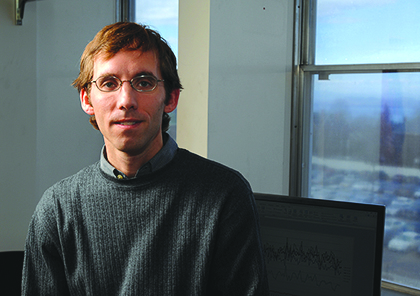In May, Vermont became the 28th state to adopt legislation mandating reporting of breast density information to patients. New University of Vermont (UVM) research - published July 18, 2016 in the Annals of Internal Medicine - shows that density assessment, as currently practiced, is subjective and highly variable across radiologists and warns of the implications of relying on the subjective measurement for clinical decision-making for breast cancer screening.

Brian Sprague, Ph.D., UVM Assistant Professor of Surgery (Photo: COM Design & Photography)
In May, Vermont became the 28th state to adopt legislation mandating reporting of breast density information to patients. New University of Vermont (UVM) research - published July 18, 2016 in the Annals of Internal Medicine - shows that density assessment, as currently practiced, is subjective and highly variable across radiologists and warns of the implications of relying on the subjective measurement for clinical decision-making for breast cancer screening.
Having dense breasts makes mammography more difficult to interpret and is also an independent risk factor for developing breast cancer. Advocacy for breast density legislation originated from women with dense breasts who were diagnosed with advanced breast cancer, despite negative mammograms. They wanted to ensure that other women with dense breasts are informed and have the opportunity to undergo supplementary screening if they desire. About half of all U.S. states currently have breast density notification laws. Some of those states require that women are advised to talk to their health care providers about supplemental screening. Such laws are controversial because of the large number of women affected (about 40 percent of women aged 40 to 74) and due to a lack of consensus in the medical community regarding supplemental screening. An additional concern is the subjective nature of breast density assessment, which is based on the Breast Imaging Reporting and Data System (BI-RADS) that provides four possible categories for breast density.
The research team, led by Brian Sprague, Ph.D., a UVM Cancer Center member and assistant professor of surgery, included collaborators from the National Cancer Institute-funded Population-based Research Optimizing Screening through Personalized Regimens (PROSPR) consortium. Using data from 30 breast imaging facilities, the researchers sought to examine variation in the distribution of breast density assessments across radiologists as recorded in clinical practice.
The researchers found that there was wide variation across radiologists in the percent of mammograms rated dense, ranging from as low as 6.3 percent to as high as 84.5 percent. In addition, more than 1 in 6 women with consecutive mammograms interpreted by different radiologists during a short period were reclassified into dense versus non-dense categories.
Sprague and the research team believe these findings have important implications for clinical decision making as well as debates about a national mandatory breast density notification law. In Vermont, the law indicates consideration of all risk factors in discussion of screening or follow-up for women of all breast densities. The study reinforces this point and encourages that although patient-provider discussions of supplemental screening may be triggered by mandatory reporting of density information, patients and physicians should consider density information as one subjective factor among many relevant risk factors to be incorporated into decision making about screening.
Results of the study also provide further evidence of the need for the development and use of objective, standardized measures of breast density in clinical practice.
Learn more about PROSPR.